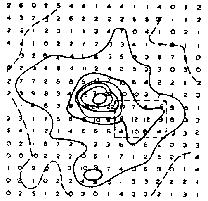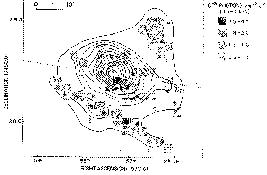


7.1. The SW Group
The existence of a subcluster at ~ 0.5° South-West of the Coma centre, around the bright galaxy NGC 4839, was already noticeable in the map of the density of nebulæ in the Coma region (see Fig. 2), that Wolf made in 1902. The presence of the SW galaxy concentration was confirmed by Shane & Wirtanen's galaxy counts, half a century later (see Fig. 13). Here is how Shane & Wirtanen described the SW subcluster:
It is apparent that there is a subsidiary concentration of nebulæ southwest of the cluster center. This grouping may be a secondary feature of the cluster or it may represent an independent aggregation.
Note that Wolf's map was not mentioned in Shane & Wirtanen's paper.
Following up Shane & Wirtanen's "discovery" of the SW subcluster, van den Bergh [145] developed the first objective method for the detection of subclustering. He measured the apparent galaxy separations in Coma, before and after scrambling the galaxy position angles, while keeping their clustercentric radial distances unchanged. He found that the apparent galaxy separations were smaller in the real cluster than in the synthetic one, and concluded:
Taken at face value, this result implies that subclustering occurs in the Coma cluster.
His result motivated Abell [2], [3] to perform his own analysis of substructure. He found evidence for subclustering in 5 out of the 7 clusters examined, but not in Coma.

|
Figure 13. The density of nebulæ in the region of Coma, according to Shane & Wirtanen. Note the south-western extension, indicated by dashed lines (north is up, east is to the left). |
Omer et al. built the Coma density profile, based on three independent galaxy counts in the Coma region, and found a clear secondary peak at 0.5° radial distance.
The apparent overall regularity of Coma led Rood & Turnrose to suggest, by analogy, that the SW concentration was rather a background group than a subcluster.
In the 70's the first X-ray maps of Coma (Gorenstein et al. [59] and Johnson et al. [75]) were produced. The limited size of these first X-ray maps did not allow the detection of the SW group. Nevertheless, a SW extension was visible in the map of Johnson et al. (see Fig. 14).

|
Figure 14. The map of the X-ray emission from Coma in the 0.5-5 keV band - from Johnson et al. |
In the 80's the SW group was finally identified also in the velocity space. Baier [12] reported (8) on Sherbanowsky [123]'s identification of a group of 12 galaxies with an average velocity of 7437 km/s in the SW of Coma. Sherbanowsky's estimate for the mean velocity of the SW group was only ~ 100 km/s higher than the current estimate (9).
Another (independent) detection of the SW group in the phase-space came from
Perea et al. [108]
Their estimates of the average velocity and
 v of the SW group,
were however offset by 200 km/s from current ones
[27].
v of the SW group,
were however offset by 200 km/s from current ones
[27].
In spite of all previous evidences on the existence of a SW subcluster,
in 1988 Dressler & Shectman
[40]
claimed  6 % probability that Coma
had substructures!
In the same year, however, Mellier et al. published their seminal paper,
in which they identified "not less than 9 local density peaks",
including
the SW group. Their estimates of the SW velocity moments
were nevertheless based on 4 galaxies only, and therefore rather uncertain.
Escalera et al. [42]
put Mellier et al.'s results on a firm statistical
basis, using the wavelet method for structure detection.
6 % probability that Coma
had substructures!
In the same year, however, Mellier et al. published their seminal paper,
in which they identified "not less than 9 local density peaks",
including
the SW group. Their estimates of the SW velocity moments
were nevertheless based on 4 galaxies only, and therefore rather uncertain.
Escalera et al. [42]
put Mellier et al.'s results on a firm statistical
basis, using the wavelet method for structure detection.
In the 90's the group around NGC 4839 was also discovered in the X-rays, first by Briel et al. using the ROSAT PSPC, and almost at the same time by Watt et al. using the SL2 XRT.
In the last years, the emphasis moved from the determination of the SW group properties to the determination of its evolution in relation to Coma. Has the group already passed through Coma, or is it infalling into the cluster for the first time? Both in the X-ray (White et al. [157]) and in the radio (Cordey [28]) there is evidence for a tail of gas behind NGC 4839, in the opposite direction to the cluster centre, as if the galaxy was falling into the Coma core, and its gaseous atmosphere was swept away by motion through an external medium. On the other hand, Burns et al. [21]'s numerical simulations suggest that the group has already passed through the cluster core (10).
The issue is still controversial (see Colless & Dunn vs. Biviano et al. [16]). Evidences in favour of the "first infall" scenario are:
Nevertheless, this scenario cannot explain the presence of a bridge of material connecting Coma and the group, detected as diffuse optical light (Mattila), as a spray of post-starburst galaxies (Caldwell et al., and Caldwell's contribution in these proceedings), in the X-ray (Briel et al.) and in the radio (Kim et al. [80]). If the group has crossed the cluster, this bridge could be interpreted as tidally stripped material from the group. The bridge is unlikely to be related to the filament connecting Coma to A1367 (see, e.g., West, these proceedings) since the filament orientation is different from that of the bridge. On the other hand, the North-East filament of the Coma supercluster has the correct orientation. Several groups are found to lie in this filament, and these are predicted to fall into the cluster in the future (West, these proceedings).
This issue could be solved by an accurate determination of the relative distances between Coma and the group, via the use of secondary distance indicators (see the preliminary results of Lima-Neto in these proceedings).
8 Sherbanowsky's paper is extremely difficult
(impossible?) to find even in very good libraries. It would
have probably remained unnoticed, had Baier not mentioned it.
Back.
9 Colless
& Dunn estimate a mean velocity of the SW group of 7339 km/s and a
velocity dispersion of 329 km/s.
Back.
10 In their
paper Burns et al. note that "the recession velocity of the NGC 4839 gr
oup
is slightly smaller (by ~ 100 km s-1) than that of the Coma cluster".
This is wrong, the recession velocity of the group is ~ 400 km/s
higher than that of Coma.
Back.